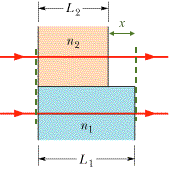A tube of length L is closed at one end. A stretched wire is placed near the open end. The wire has a length l and has mass m. It is fixed at both ends and oscillates in its fundamental mode. By resonance, it sets the air column in the tube into oscillation at the column's fundamental frequency. Find that frequency and the tension in the wire. (Use any variable or symbol stated above along with the following as necessary: vs for the speed of sound.)
.png)
.png)
The answers for this come almost directly out of the textbook. Look at Eq. 17.19, and the discussion leading up to it. Differences between that discussion and this question are:
- They are doing superposition of two waves traveling along the same direction, instead of potentially going in different directions. But the direction of wave travel has no impact on the disturbance at a single point.
- They are writing equations for displacement instead of pressure. But that is just replacing one variable for another.
- They are using cosine instead of sine functions. But that is just making a different choice for when t = 0.
More important are the commonalities: Both are about superposition (Δp' = Δp1+Δp2; note that there are no m subscripts in that sum), and both are solved with the same trigonometry identity (given in the textbook at Eq. 16-50). You can either re-apply that trig identity to the case here, or you can rely on the commonalities to recognize that Eq. 17.19 solves the question directly.
All the answers are calculated from the formula 2 cos(φ/2) . All of the combined amplitudes are multiples of the (unknown) amplitude Δpm, but the question only requires you to enter the multiplier.
 Two waves of light in air, of wavelength λ = 610.0nm, are initially in phase. They then travel through plastic layers as shown in Figure 35-36, with L1 = 4.00μm, L2 = 3.50μm, n1 = 1.35, and n2 = 1.60.
Two waves of light in air, of wavelength λ = 610.0nm, are initially in phase. They then travel through plastic layers as shown in Figure 35-36, with L1 = 4.00μm, L2 = 3.50μm, n1 = 1.35, and n2 = 1.60.
(a) What is their phase difference in cycles after they both have emerged from the layers and arrived at the same horizontal position? Include any full cycles as well as fractional cycles.
First, it is crucial to identify the parts of the paths that differ from one another. These are the parts between the green dashed lines I've added. Note that path 2 (the top one) includes a distance x in air.
TWO APPROACHES:
(1) FULL PATH APPROACH: The number of cycles along path 1 is N1 = L1n1 /λ . The number of cycles along path 2 is N2 = L2n2 /λ +x /λ . The difference is then ΔN = N2−N1 .
(2) BREAK INTO PIECES APPROACH: Along the initial length of L2 the cycle difference is given by Eq. 35-9 as ΔNA = (n2−n1)L2 /λ . Along the next length of x the cycle difference is ΔNB = (1−n1)x /λ (where path 2 is traveling through a refractive index of 1). Then the total accumulated cycle difference is
ΔN = ΔNA+ΔNB .
Either approach will give the same answer. I find approach (1) simpler and easier to understand. But I suppose that approach (2) has the advantage of using an equation from the book... if you like that sort of thing.
(b) If the waves at that later position are brought together to a single point, what type of interference occurs?
Although part (a) required including the full cycles, on the fractional part tells about the type of interference. If the fractional part is closer to 0.5 than 0.0 (that is, if it is between 0.25 and 0.75), then it is closer to destructive interference. If the fractional part is closer to 0.0 (that is, if it is less than 0.25 or more than 0.75), then it is closer to constructive interference.
Side note: This is asking whether the phase difference is closer to constructive or destructive. Even at the boundary case of ΔN = 0.25 the amplitude of the combination will be larger than the amplitde of either initial beam.
You could make an equally good argument that the boundary case should be when the combined amplitude is the same as the initial amplitudes. The answer then depends on the relative amplitudes of the two beams, but if the two beams are the same, then we would be "closer to destructive" for ΔN between 1/3 and 2/3.